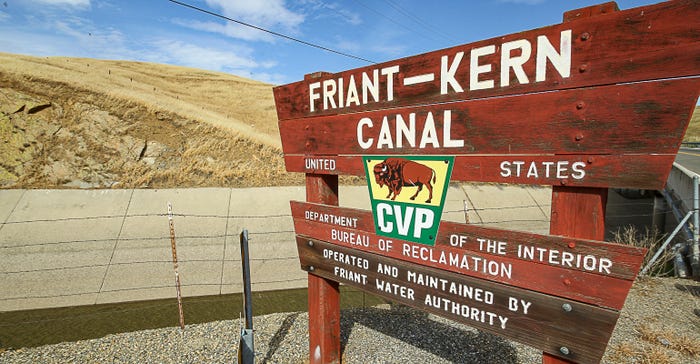
The Friant-Kern Canal conveys water from Millerton Lake near Fresno to Bakersfield. Along the way, the 152-mile system delivers surface irrigation supplies to farms, and makes water available to cities without adequate well water supplies in the San Joaquin Valley. A 33-mile segment of the canal will get $187 million in repairs done over the next two years to restore carrying capacity and deliveries to farms and urban users in California's San Joaquin Valley.Todd Fitchette
Efforts to restore water deliveries in the Friant Kern Canal are underway after years of failed attempts to secure state funding to repair crumbling infrastructure.
Officials this week celebrated a groundbreaking along the canal's most-impacted points in southern Tulare County, Calif.. Once complete, the project is designed to restore flows in the canal to the original 4,000 cubic feet per second. Current carrying capacity is about 1,600 cfs because of significant ground subsidence in the region that caused segments of the canal to sink, restricting its flow.
The canal system has suffered from subsidence for decades. This is the gradual sinking of land due to the over pumping of ground water. This reduced its ability to convey water to farms and cities by over 50%.
A consortium of local, state, and federal officials was on hand Jan. 25 to break ground on a project that starts with the creation of a 10-mile-long parallel lined canal along the middle section of the current canal. That project is estimated to be complete by January 2024, according to a statement from the Friant Water Authority. Friant manages the canal in a partnership with the U.S. Bureau of Reclamation (USBR).
The $187 million project is funded by USBR, the Friant Water Authority and California Department of Water Resources.
According to Friant Water Authority Spokesperson Alex Biering, funding came from commitments by Gov. Gavin Newsom and $8.3 billion in federal funds to the Bureau of Reclamation under President Biden's recent infrastructure law. Additional money has been proposed by Gov. Newsom through next year's state budget.
Biering said the project, once complete, will give Friant the ability to manage flood flows once again and help promote groundwater recharge while enhancing surface water deliveries to growers and cities along the 152-mile canal system.
"This will also ensure we don't lose the ability to take on extra capacity during high flow events like we saw in 2017," she said.
About the Author(s)
You May Also Like






